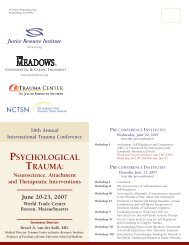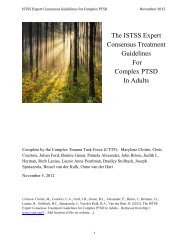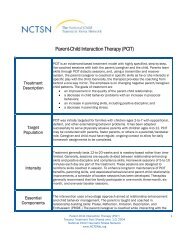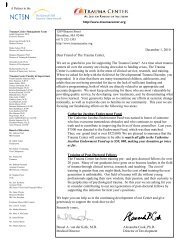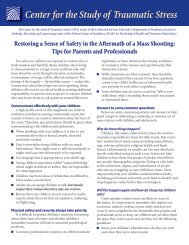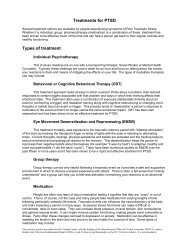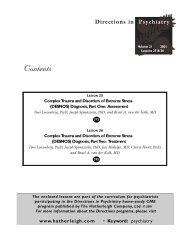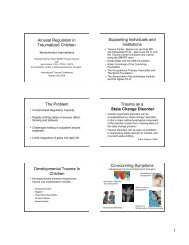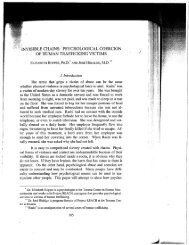in Child Welfare - The Trauma Center
in Child Welfare - The Trauma Center
in Child Welfare - The Trauma Center
You also want an ePaper? Increase the reach of your titles
YUMPU automatically turns print PDFs into web optimized ePapers that Google loves.
CW360 o <strong>Trauma</strong>-Informed <strong>Child</strong> <strong>Welfare</strong> Practice • W<strong>in</strong>ter 2013 23been described (Dorsey & Debl<strong>in</strong>ger, <strong>in</strong>press).Dur<strong>in</strong>g each subsequent TF-CBTcomponent youth use cop<strong>in</strong>g skills totolerate gradually <strong>in</strong>creas<strong>in</strong>g exposure to theirtrauma rem<strong>in</strong>ders, a process called “gradualexposure”. Caregivers (e.g., biological orfoster parents) participate <strong>in</strong> parallel parent<strong>in</strong>gsessions throughout TF-CBT treatment.However, youth with frequent changes <strong>in</strong>placement, youth without caregiver contact,or youth who refuse to allow the caregiverto participate <strong>in</strong> treatment can also receiveTF-CBT. For these youth, TF-CBT engagesthe youth <strong>in</strong> the youth-focused componentsof TF-CBT while simultaneously attempt<strong>in</strong>gto create a supportive network from otheravailable adults (www.cdc.gov). If feasible,another supportive adult may eventuallyparticipate <strong>in</strong> the youth’s TF-CBT treatment.<strong>The</strong> early cop<strong>in</strong>g skills phase consists ofbuild<strong>in</strong>g skills for the youth to use whenconfronted with trauma rem<strong>in</strong>ders and touse generally when experienc<strong>in</strong>g regulationdifficulties. <strong>The</strong>se skills are also importantfor the caregiver. Psychoeducation helps thecaregiver to view the youth’s problems asbe<strong>in</strong>g related to his past trauma experiencesrather than simply as “bad” behavior.Parent<strong>in</strong>g skills provide the caregiver withtools to more effectively respond to theyouth’s trauma-related regulation problems.For children like Maria, a step- by-step <strong>in</strong>vivo (<strong>in</strong> real life) plan will help her masterher fear of sleep<strong>in</strong>g <strong>in</strong> her own bed. S<strong>in</strong>ce thismay take several weeks, the <strong>in</strong> vivo masterywill beg<strong>in</strong> early <strong>in</strong> TF-CBT. For youth likeRobert with serious behavioral problems, itmay take 10-12 sessions to achieve reasonablestability and self-regulation (Cohen, Berl<strong>in</strong>er& Mannar<strong>in</strong>o, 2010; Cohen, Mannar<strong>in</strong>o,Kliethermes & Murray, <strong>in</strong> press).<strong>The</strong> next phase of TF-CBT is trauma narrativeand process<strong>in</strong>g. Dur<strong>in</strong>g this phasethe youth develops and processes a detaileddescription of his trauma experiences. A youthwho has lived through chronic, multipletraumas may create a narrative focus<strong>in</strong>g on histrauma theme (Cohen, et al, 2012). Creat<strong>in</strong>gand process<strong>in</strong>g the narrative typically takesabout 1/3 of the TF-CBT treatment.After the youth has created and come to a betterunderstand<strong>in</strong>g of these experiences dur<strong>in</strong>gsessions with the therapist and the therapisthas shared this narrative with the caregiver <strong>in</strong><strong>in</strong>dividual sessions, the youth shares it withthe caregiver <strong>in</strong> conjo<strong>in</strong>t youth-caregiversessions. With appropriate preparation thesesessions are highly reward<strong>in</strong>g and validat<strong>in</strong>gsessions for youth and caregivers. F<strong>in</strong>ally,re-establish<strong>in</strong>g a sense of safety for youth <strong>in</strong>child welfare is critical. For many youth <strong>in</strong>child welfare this is the most critical componentand TF-CBT may beg<strong>in</strong> and end withestablish<strong>in</strong>g trust and safety.TF-CBT Effectivenessfor Youth <strong>in</strong> <strong>Child</strong> <strong>Welfare</strong>A dozen RCT studies have shown the effectivenessof TF-CBT <strong>in</strong> improv<strong>in</strong>g multipleoutcomes (e.g., PTSD, depression, anxiety,behavior problems, youth cognitions, parent<strong>in</strong>goutcomes) after traumas commonly experiencedby youth <strong>in</strong> child welfare (e.g., sexualabuse, domestic violence, multiple traumas).Two studies specifically focused on youth <strong>in</strong>child welfare. <strong>The</strong> first study exam<strong>in</strong>ed youth<strong>in</strong> care <strong>in</strong> Ill<strong>in</strong>ois, compar<strong>in</strong>g TF-CBT toyouth receiv<strong>in</strong>g Systems of Care treatmentas usual (SOC). TF-CBT was significantlysuperior to SOC <strong>in</strong> improv<strong>in</strong>g PTSD symptoms,emotional and behavioral problems asmeasured by the <strong>Child</strong> and Adolescent Needsand Strengths (CANS) and <strong>in</strong> prevent<strong>in</strong>gplacement disruption and runn<strong>in</strong>g awayfrom current placement (We<strong>in</strong>er, Schneider& Lyons, 2009). <strong>The</strong> other exam<strong>in</strong>ed theeffectiveness of TF-CBT with or withoutan additional module for engag<strong>in</strong>g fosterparents. This study found that the engagementstrategy significantly improved fosterparents engagement <strong>in</strong> their youths’ TF-CBTtreatment but otherwise did not change youthoutcomes, with both groups experienc<strong>in</strong>g significantimprovement after receiv<strong>in</strong>g TF-CBT(Dorsey, 2011).For more <strong>in</strong>formation about TF-CBT, therapistscan refer to the free TF-CBT tra<strong>in</strong><strong>in</strong>gresources available at www.musc.edu/tfcbt,www.musc.edu/ctg and www.musc.edu/tfcbtconsult.Information about upcom<strong>in</strong>g TF-CBT tra<strong>in</strong><strong>in</strong>g is available at www.musc.edu/tfcbt under “Resources.” <strong>The</strong> location of over200 TF-CBT tra<strong>in</strong>ed cl<strong>in</strong>icians <strong>in</strong> M<strong>in</strong>nesotais available at www.ambitnetwork.org.Judith Cohen, MD is Medical Directorof the <strong>Center</strong> for <strong>Trauma</strong>tic Stress <strong>in</strong><strong>Child</strong>ren & Adolescents at AlleghenyGeneral Hospital <strong>in</strong> Pittsburgh PA andProfessor of Psychiatry at the DrexelUniversity College of Medic<strong>in</strong>e. She canbe reached at Jcohen1@wpahs.org.Anthony Mannar<strong>in</strong>o, PhD is Chairman,Department of Psychiatry, and Directorof the <strong>Center</strong> for <strong>Trauma</strong>tic Stress <strong>in</strong><strong>Child</strong>ren and Adolescents at AlleghenyGeneral Hospital, Pittsburgh, PA. Heis also Professor of Psychiatry at theDrexel University College of Medic<strong>in</strong>e.He can be reached at amannari@wpahs.org.Practice




